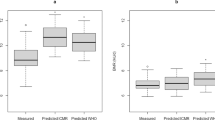Abstract
Objective: To investigate to what extent individual energy intakes can be predicted by rapid easily available low-cost estimation methods.
Design: Data were obtained from a controlled dietary intervention study period of nine weeks in which the subjects should be weight stable.
Subjects: Thirty-one male students in domestic and kitchen management aged 29±6 y.
Methods: (1) energy intake calculated from a quantitative food frequency questionnaire (FFQEI); (2) energy expenditure derived from estimates of basal metabolic rate (BMR) (FAO/WHO/UNU, 1985) based on weight, gender, age and low (1.55×BMR), medium (1.78×BMR) or high (2.10×BMR) level of activity. Level of activity was determined by questions concerning habitual activities lasting more than 20 min (WHOEE); (3) energy expenditure derived from individual recording in a specially prepared activity diary (ADEE). During the intervention, the subjects were to be fed test diets which should provide them with enough energy to keep them weight stable. The energy levels were established after taking both the FFQEIs, WHOEEs and ADEEs into consideration, and 10 MJ, 13 MJ, 15 MJ and 17 MJ per day were chosen because these levels were estimated to closely match the energy requirements of most of the subjects. The levels of energy were changed during the intervention period if the weight of the subjects fluctuated. The served level of energy at the last day of the intervention was denoted the weight maintenance energy intake (WMEI). WMEI was compared to FFQEI, WHOEE and ADEE in order to evaluate if one estimation method predicted WMEI better than the two others.
Results: None of the three methods provided accurate estimates of WMEI of 13.3±1.8 MJ. However, WHOEE, gave the best estimate as demonstrated by the limits of agreement: −8.7 MJ to +8.9 MJ for FFQEI, −5.4 MJ to +3.9 MJ for WHOEE and −7.2 MJ to +5.2 MJ for ADEE. The coefficients of correlation between the differences and the means of WMEI and FFQEI, WHOEE and ADEE were −0.8 (P≤0.001), 0.1 (P=0.6, NS) and −0.5 (P≤0.01), respectively. The coefficients of variation were 34.6% for FFQEI, 11.3% for WHOEE, and 21.0% for ADEE.
Conclusions: Although not precise, WHOEE showed the best agreement with the WMEI. These results demonstrate that a rapid and simple low-cost method predicted WMEI closely enough to avoid major weight fluctuations among these men during the intervention period.
Sponsorship: Supported by The Research Society of the Norwegian Edible Fat Producers and the food company Mills DA, Oslo, Norway.
This is a preview of subscription content, access via your institution
Access options
Subscribe to this journal
Receive 12 print issues and online access
$259.00 per year
only $21.58 per issue
Buy this article
- Purchase on Springer Link
- Instant access to full article PDF
Prices may be subject to local taxes which are calculated during checkout
Similar content being viewed by others
Author information
Authors and Affiliations
Rights and permissions
About this article
Cite this article
Almendingen, K., Trygg, K. & Pedersen, J. An assessment of the use of simple methods to predict individual energy intakes for intervention studies. Eur J Clin Nutr 52, 54–59 (1998). https://doi.org/10.1038/sj.ejcn.1600515
Received:
Revised:
Accepted:
Published:
Issue Date:
DOI: https://doi.org/10.1038/sj.ejcn.1600515
Keywords
This article is cited by
-
Spatial heterogeneity of low-birthweight deliveries on the Kenyan coast
BMC Pregnancy and Childbirth (2023)
-
Early neurological and motor function in infants born moderate to late preterm or small for gestational age at term: a prospective cohort study
BMC Pediatrics (2023)
-
Role of Maternal Nutrition on Gestational Age and Birth Weight
National Academy Science Letters (2012)
-
Factors Predicting Birth Weight in a Low-Risk Sample: The Role of Modifiable Pregnancy Health Behaviors
Maternal and Child Health Journal (2007)
-
Modulation of COX-2 expression in peripheral blood cells by increased intake of fruit and vegetables?
European Journal of Clinical Nutrition (2005)



